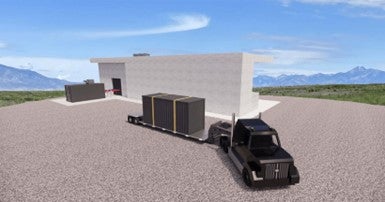
The US Department of Defense (DOD) has broken ground on the Project Pele transportable microreactor project at Idaho National Laboratory (INL). The demonstration project is led by DOD’s Strategic Capabilities Office.
DOD is planning to design, build, and demonstrate a transportable high-temperature gas-cooled reactor that will operate at INL’s Critical Infrastructure Test Range Complex.
The reactor, generating 1-5 MWe, will be manufactured by BWXT Advanced Technologies with assembly of the final reactor set to begin in February 2025. According to DOD, the prototype reactor facility will be transported in 20-foot shipping containers and tested at the lab. The reactor will then be moved by truck for placement at the complex “during the 2026 timeframe” to conduct safety reviews and initial planning and testing.
“We are thrilled to move beyond the era of PowerPoint advanced reactors,” said Dr Jeff Waksman, Project Pele programme manager. “Our tight partnership with INL and the Department of Energy Idaho Operations Office is trailblazing not just for manufacturing advanced reactors, but also for regulating them in an efficient and safe manner.”
INL Director Dr John Wagner said: “We anticipate Pele will be among the first of a new generation of advanced experimental reactors hosted here before the end of the decade.”
Project Pele is a whole-of-government effort, with critical expertise provided by the Department of Energy (DOE), the Nuclear Regulatory Commission (NRC), US Army Corps of Engineers USACE), NASA, and the National Nuclear Security Administration (NNSA). The contractor team, led by BWXT, also includes critical roles played by Northrop Grumman, Rolls Royce Liberty Works, and Torch Technologies.
The reactor is expected to operate for a minimum of three years at INL and will help demonstrate the use of clean, reliable, and transportable nuclear power to help meet the increasing energy demands at military bases across the country.
BWXT will leverage its experience from Project Pele to advance its civil-focused BANR microreactor, which is being supported by DOE’s Advanced Reactor Demonstration Program (ARDP). The work will help to support a domestic supply chain for high-temperature gas reactor components and services, and manufacture TRISO fuel at production quantities.
Upon arrival at INL, the reactor will be transported by truck to the test site and positioned within the concrete shield structure. Piping and electrical wiring will tie the reactor to INL’s specialised electric microgrid. Once the reactor’s final safety review is completed, the Pele project team will then proceed with the initial Test and Evaluation plan.
In 2016 the Defense Science Board (DSB) identified energy as a critical enabler of future military operations. The study noted that battlefield energy usage will likely increase significantly over the next few decades with energy needs of current and future military capabilities and operations likely outpacing improvements to energy efficiency and management. The DSB found that intermittent character of many alternative energy sources do not appear able to keep pace with the growth of DOD’s energy needs.
This led to the launch of Project Pele, the objective of which is to design, build, and demonstrate a prototype mobile nuclear reactor within five years, following the DSB study recommendations. This effort will leverage state-of-the-art technologies and recent advances in nuclear engineering to deliver an inherently safe nuclear reactor. The reactor will be designed to provide reliable and resilient power, while minimising risk of nuclear proliferation, environmental damage, or harm to nearby personnel or populations.
Researched and written by Judith Perera






